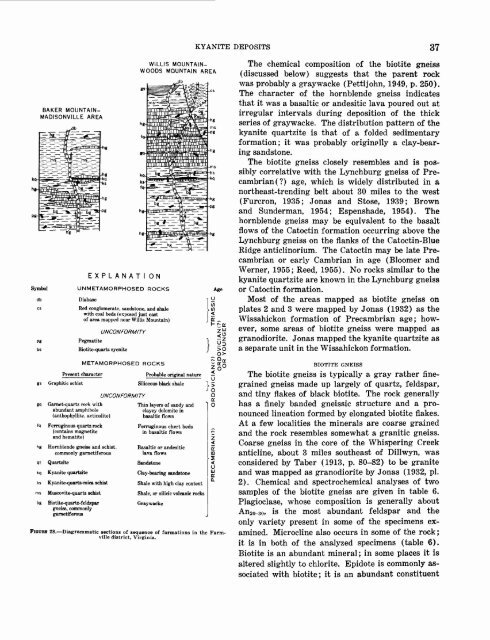Kyanite, Sillimanite, and Andalusite Deposits of the Southeastern ...
Kyanite, Sillimanite, and Andalusite Deposits of the Southeastern ...
Kyanite, Sillimanite, and Andalusite Deposits of the Southeastern ...
Create successful ePaper yourself
Turn your PDF publications into a flip-book with our unique Google optimized e-Paper software.
KYANITE DEPOSITS 37<br />
BAKER MOUNTAIN-<br />
MADISONVILLE AREA<br />
Symbol<br />
f q<br />
hg<br />
qt<br />
kq<br />
ks<br />
ms<br />
bg<br />
EXPLANATION<br />
UNMETAMORPHOSED ROCKS<br />
Red conglomerate, s<strong>and</strong>stone, <strong>and</strong> shale<br />
with coal beds (exposed just east<br />
<strong>of</strong> area mapped near Willis Mountain)<br />
UNCONFORMITY<br />
Pegmatite<br />
Biotite-quartz syenite<br />
METAMORPHOSED ROCKS<br />
Present character<br />
Graphitic schist<br />
WILLIS MOUNTAIN-<br />
WOODS MOUNTAIN AREA<br />
Probable original nature<br />
Siliceous black shale<br />
UNCONFORMITY<br />
Garnet-quartz rock with<br />
Thin layers <strong>of</strong> s<strong>and</strong>y <strong>and</strong><br />
abundant amphibole<br />
(anthophyllite, actinolite)<br />
clayey dolomite in<br />
basaltic flows<br />
Ferruginous quartz rock<br />
(contains magnetite<br />
<strong>and</strong> hematite)<br />
Hornblende gneiss <strong>and</strong> schist,<br />
commonly -garnetif erous<br />
Quartzite<br />
<strong>Kyanite</strong> quartzite<br />
<strong>Kyanite</strong>-quartz-mica schist<br />
Muscovite-quartz schist<br />
Biotite-quartz-feldspar<br />
gneiss, commonly<br />
garnetif erous<br />
Ferruginous chert beds<br />
in basaltic flows<br />
Basaltic or <strong>and</strong>esitic<br />
lava flows<br />
S<strong>and</strong>stone<br />
Clay-bearing s<strong>and</strong>stone<br />
Shale with high clay content<br />
Shale, or silicic volcanic rocks<br />
Graywacke<br />
Age<br />
TRIASS<br />
ORDOVICIANf?)<br />
ORDOVICIANt?)<br />
YOUNGER OR<br />
FIGURE 28. Diagrammatic sections <strong>of</strong> sequence <strong>of</strong> formations in <strong>the</strong> Farmville<br />
district, Virginia.<br />
The chemical composition <strong>of</strong> <strong>the</strong> biotite gneiss<br />
(discussed below) suggests that <strong>the</strong> parent rock<br />
was probably a graywacke (Pettijohn, 1949, p. 250).<br />
The character <strong>of</strong> <strong>the</strong> hornblende gneiss indicates<br />
that it was a basaltic or <strong>and</strong>esitic lava poured out at<br />
irregular intervals during deposition <strong>of</strong> <strong>the</strong> thick<br />
series <strong>of</strong> graywacke. The distribution pattern <strong>of</strong> <strong>the</strong><br />
kyanite quartzite is that <strong>of</strong> a folded sedimentary<br />
formation; it was probably originally a clay-bearing<br />
s<strong>and</strong>stone.<br />
The biotite gneiss closely resembles <strong>and</strong> is possibly<br />
correlative with <strong>the</strong> Lynchburg gneiss <strong>of</strong> Precambrian(?)<br />
age, which is widely distributed in a<br />
nor<strong>the</strong>ast-trending belt about 30 miles to <strong>the</strong> west<br />
(Furcron, 1935; Jonas <strong>and</strong> Stose, 1939; Brown<br />
<strong>and</strong> Sunderman, 1954; Espenshade, 1954). The<br />
hornblende gneiss may be equivalent to <strong>the</strong> basalt<br />
flows <strong>of</strong> <strong>the</strong> Catoctin formation occurring above <strong>the</strong><br />
Lynchburg gneiss on <strong>the</strong> flanks <strong>of</strong> <strong>the</strong> Catoctin-Blue<br />
Ridge anticlinorium. The Catoctin may be late Precambrian<br />
or early Cambrian in age (Bloomer <strong>and</strong><br />
Werner, 1955; Reed, 1955). No rocks similar to <strong>the</strong><br />
kyanite quartzite are known in <strong>the</strong> Lynchburg gneiss<br />
or Catoctin formation.<br />
Most <strong>of</strong> <strong>the</strong> areas mapped as biotite gneiss on<br />
plates 2 <strong>and</strong> 3 were mapped by Jonas (1932) as <strong>the</strong><br />
Wissahickon formation <strong>of</strong> Precambrian age; however,<br />
some areas <strong>of</strong> biotite gneiss were mapped as<br />
granodiorite. Jonas mapped <strong>the</strong> kyanite quartzite as<br />
a separate unit in <strong>the</strong> Wissahickon formation.<br />
BIOTITE GNEISS<br />
The biotite gneiss is typically a gray ra<strong>the</strong>r finegrained<br />
gneiss made up largely <strong>of</strong> quartz, feldspar,<br />
<strong>and</strong> tiny flakes <strong>of</strong> black biotite. The rock generally<br />
has a finely b<strong>and</strong>ed gneissic structure <strong>and</strong> a pronounced<br />
lineation formed by elongated biotite flakes.<br />
At a few localities <strong>the</strong> minerals are coarse grained<br />
<strong>and</strong> <strong>the</strong> rock resembles somewhat a granitic gneiss.<br />
Coarse gneiss in <strong>the</strong> core <strong>of</strong> <strong>the</strong> Whispering Creek<br />
anticline, about 3 miles sou<strong>the</strong>ast <strong>of</strong> Dillwyn, was<br />
considered by Taber (1913, p. 80-82) to be granite<br />
<strong>and</strong> was mapped as granodiorite by Jonas (1932, pi.<br />
2). Chemical <strong>and</strong> spectrochemical analyses <strong>of</strong> two<br />
samples <strong>of</strong> <strong>the</strong> biotite gneiss are given in table 6.<br />
Plagioclase, whose composition is generally about<br />
An20-3o, is <strong>the</strong> most abundant feldspar <strong>and</strong> <strong>the</strong><br />
only variety present in some <strong>of</strong> <strong>the</strong> specimens examined.<br />
Microcline also occurs in some <strong>of</strong> <strong>the</strong> rock;<br />
it is in both <strong>of</strong> <strong>the</strong> analyzed specimens (table 6).<br />
Biotite is an abundant mineral; in some places it is<br />
altered slightly to chlorite. Epidote is commonly associated<br />
with biotite; it is an abundant constituent
















